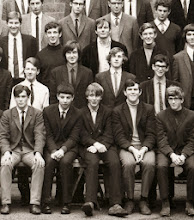
..and a little bit of that... Here's a foursome of books from the North East which show the diversity of life in that part of the North, for better and worse. Gary's Friends by Adrian Clarke (West Pier Press 2007) is a photographic essay on a group of drink and drug abusers on Tyneside and Teeside which may sound off-putting but is actually a riveting social document. It shows how closely a dismal way of life may be related to something quite different; one of the people who bravely agreed to be photographed and tell a summary of their life story is a cousin of Bob Crooks, the marvellous, long-standing chairman of Durham county council who features in True North. Another of his relatives was Sammy Crooks, the England footballer, and a third was Mayor of Durham city. The role played by family breakdown in creating individual disaster is desperately apparent in this book.
 There's more gritty material in A Hole Like That - 13 Cleveland Poets, edited by Mark Robinson (Scratch 1994) and just one of shelves of excellent verse to come from the North East's grassroots (which are, after all, the home of the famous Bloodaxe imprint - www.bloodaxebooks.com - among others. It isn't only grit, though. The poets also reflect on the beautiful countryside which surrounds the industrial heartland by the Tees.
There's more gritty material in A Hole Like That - 13 Cleveland Poets, edited by Mark Robinson (Scratch 1994) and just one of shelves of excellent verse to come from the North East's grassroots (which are, after all, the home of the famous Bloodaxe imprint - www.bloodaxebooks.com - among others. It isn't only grit, though. The poets also reflect on the beautiful countryside which surrounds the industrial heartland by the Tees. Off to the coast next, in the company of All Her Glories Past by David Phillipson (Smith Settle 1994), which tells the story of the Zetland lifeboat and her immensely long service at Redcar where she remains a visitor attraction.
Off to the coast next, in the company of All Her Glories Past by David Phillipson (Smith Settle 1994), which tells the story of the Zetland lifeboat and her immensely long service at Redcar where she remains a visitor attraction.  Similar, lesser-known attractions abound in The Hidden Places of Northumberland and Durham by Emma Roberts (Travel Publishing 2003), which also has handy recommendations of places to stay on a visit. I have more than half-a-dozen Southern friends, who are otherwise staunchly metropolitan, but never let a year go by without a visit to Northumberland, both inland in the lovely and lonely National Park, or along the sensational coast. Alnmouth is the second best treat from the East Coast mainine after Durham and Holy Island is extraordinary. The pub there is the only place in the UK where I have listened to compatriots speaking English and been unable to understand them. Emma Roberts' book is one of a 'county' series and I've made good use of the Yorkshire volumes as well.
Similar, lesser-known attractions abound in The Hidden Places of Northumberland and Durham by Emma Roberts (Travel Publishing 2003), which also has handy recommendations of places to stay on a visit. I have more than half-a-dozen Southern friends, who are otherwise staunchly metropolitan, but never let a year go by without a visit to Northumberland, both inland in the lovely and lonely National Park, or along the sensational coast. Alnmouth is the second best treat from the East Coast mainine after Durham and Holy Island is extraordinary. The pub there is the only place in the UK where I have listened to compatriots speaking English and been unable to understand them. Emma Roberts' book is one of a 'county' series and I've made good use of the Yorkshire volumes as well.Oh, just as a PS to this post, I had a wonderful time at Headingley LitFest, helped by knowing almost every inch of that distinguished suburb. This is a genetic thing. My mum, who came to the talk and enjoyed the scones and butterfly buns (as I did), was born in St Michael's Villas and was also left wailing as a toddler in Shire Oak Road - where the talk was - by my Grandad who thought she'd shut up if he pretended to abandon her and hid behind a wall. She claims it just made her bawl louder than ever. The Litfest has posted a generous account of proceedings on their blog at http://headingleylitfest.blogspot.com/2010/03/martin-we-loved-you.html I immodestly like the title of that link...



























